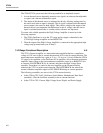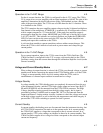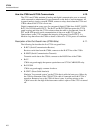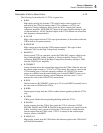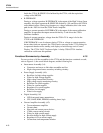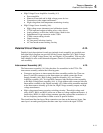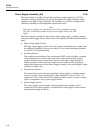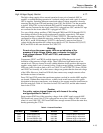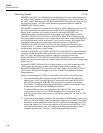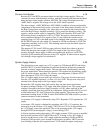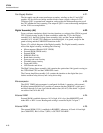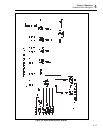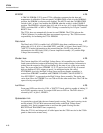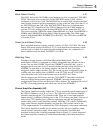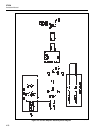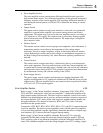
5725A
Instruction Manual
4-14
Switching Section 4-18.
MOSFETs Q301/Q317 and Q302/Q318 (each in parallel) are series-switch elements for
the +400V supply. Similarly, Q312/Q319 and Q313/Q320 are series-switch elements for
the -400V supply. Resistor pairs R301/R302 and R342/R343 equalize the voltage across
the transistors in their "off" state. Series transistors guarantee operation within the
MOSFET 500V absolute rating.
The MOSFET switches are controlled by the signal at TP305. When this point is at +5V,
the series connected base-emitter junctions of Q305/Q307 and Q304/Q306 are zero
biased. In this condition, only leakage current flows through Q305/Q307 and
Q304/Q306, which is insufficient to develop enough source-gate voltage to turn on
Q301/Q317, Q302/Q318, Q312/Q319, or Q313/Q320. When TP305 is taken low, the
series base-emitter junctions are now forward biased sufficiently so that the Q305/Q307
and Q304/Q306 pairs conduct with about 0.5 mA collector current. This current flows
through the source-gate resistor and zener diode bias networks of Q301/Q317,
Q302/Q318, Q312/Q319, and Q313/Q320. The zener diodes limit the source-gate
voltage to near 15V, which is enough to turn on the MOSFETs completely without
exceeding their source-gate voltage ratings.
Transistors Q303/Q321, Q311/Q323, Q315/Q322, and Q316/Q324 are emitter followers
that prevent Q305 and Q307 from experiencing excessive collector-emitter voltages in
their "off" state. The networks of resistors, capacitors, and diodes formed by
R344/C305/CR305, R327/C304/CR316 and R345/C306/CR309 are included to slow
supply turn-on to prevent a transient current-limiting condition, while still allowing rapid
supply turn-off.
Resistors R310/R311/R306 provide a divided voltage for low-level monitoring of the
+400V supply by the analog monitor on the High Voltage Sense assembly (A6).
Resistors R332/R346/R347 do the same for the -400V supply. Diodes CR314, CR315,
CR319, and CR320 prevent damage to the series-switches from inductive kickback
during shutdown.
Control over the potential at TP305 is controlled in one of the two following ways:
1. In normal operation (P301 plugged onto the E301 header where the label SYS
appears, pins 1 and 2), the microprocessor strobes the control data HVSUPPLY*
into U302 by pulsing HVSTROBE. This action occurs in parallel with writing
HVSUPPLY* information into a latch on the High Voltage Sense assembly (A6),
but there the sense of the HVSTROBE line is inverted.
Transistor Q304 provides correct polarity to the clock of U302. At any time, the
supply can be switched off (i.e., TP305 brought to +5V) independent of the
processor by the current-limit circuitry or by SW301 pulling the "set" line of U302
high (TP306).
2. To turn on a Power Supply assembly (A4) by itself for troubleshooting, you can plug
P301 onto the E302 header where the label MAN appears (pins 2 and 3). This allows
momentary-contact pushbutton switch SW302 to generate a strobe signal for U302,
turning the supplies on. You turn the supplies off by pressing switch SW301. You
may wish to troubleshoot in the low-voltage mode by plugging the high voltage
secondary plug into J303. Section 7 contains the procedures to do this.



